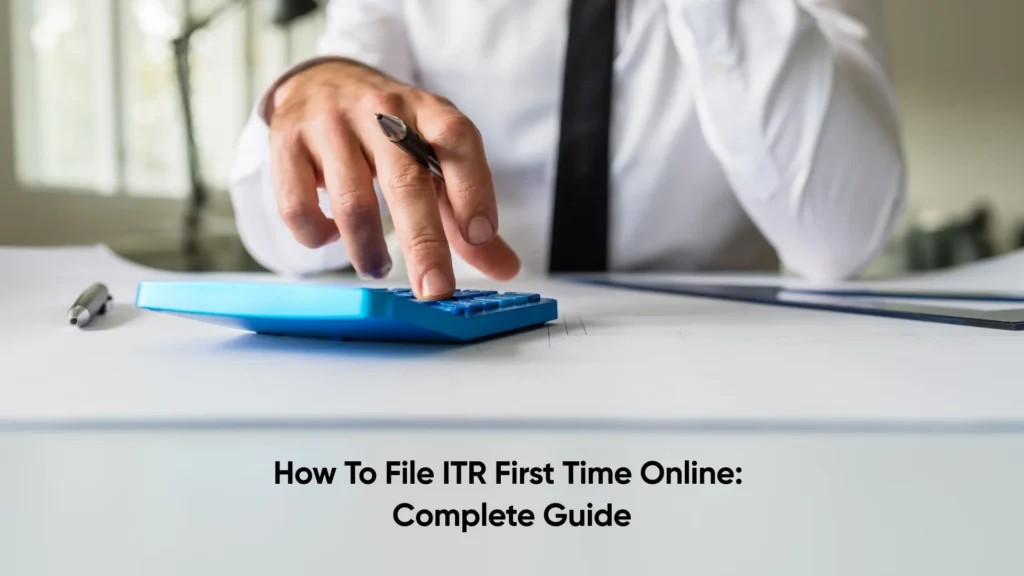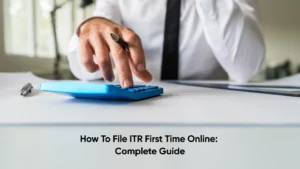Filing your Income Tax Return (ITR) for the first time can feel a little intimidating, but it doesn’t have to be. With the government’s e-filing system, the process is now 100% digital, faster, and simpler than ever. Whether you’re a salaried employee who has just started working, a freelancer, or someone earning income from investments, understanding how to file ITR first time is an important financial responsibility.
In this guide, we’ll walk you through the basics of ITR, who needs to file it, the documents you’ll need, a step-by-step guide on how to file an income tax return for the first time online, common mistakes to avoid, and the long-term benefits of timely filing. Let’s get started!
Table of Contents
ToggleWhat is Income Tax Return (ITR)?
An Income Tax Return (ITR) is a form that taxpayers in India file with the Income Tax Department to report their income, expenses, deductions, and taxes paid during a financial year. Think of it as a financial statement where you declare how much you earned and how much tax you’ve already paid or need to pay.
For first-time filers, it’s important to know that filing ITR is not just about paying taxes but also about building your financial credibility. Timely filing helps you claim refunds if excess tax has been deducted, carry forward certain losses, and stay compliant with the law. If you’re looking to build a good financial track record, especially for future loans, filing your ITR regularly is essential.
Who Needs to File Income Tax Return for the First Time?
If you’re filing for the first time, you might be wondering whether it’s mandatory for you. The Income Tax Act makes it compulsory for individuals who meet certain criteria to file their returns. Here are some common cases where you need to file ITR for the first time:
- If Your Total Income Exceeds The Basic Exemption Limit (₹2.5 lakh for individuals below 60 years).
- Salaried Individuals whose employers have deducted TDS but total income crosses the exemption threshold.
- Freelancers, Self-Employed Professionals, And Consultants who earn taxable income.
- Individuals with Multiple Income Sources, such as salary plus rental income or investments.
- Residents with Foreign Assets or Income, even if income is below the exemption limit.
- If You Want to Claim an Income Tax Refund (for example, if excess TDS has been deducted).
So, if you’ve just started earning or investing, this is the right time to learn how to file an income tax return for the first time.
Also Read: Advance Tax Calculation Format, Slab & How to Calculate
Documents Required to File ITR for the First Time
Before you begin, keep all necessary documents handy. Having these will make the process smooth and error-free:
- PAN Card – Mandatory for filing ITR.
- Aadhaar Card – For linking and e-verification.
- Form 16 – Issued by your employer, showing salary and TDS details.
- Bank account details – Including account number, IFSC code, and statements.
- Form 26AS / AIS (Annual Information Statement) – Summarizes your tax credit and TDS.
- Investment proofs – ELSS, PPF, LIC, or other Section 80C investments.
- Home loan or education loan statements, if applicable.
- Capital gains statements – For income from shares, mutual funds, or property.
Having this checklist ready is half the work done for first-time filers.
Also Read: Know Difference Between Form 16, For 16A & Form 16B
Step-by-Step Guide on How to File ITR First Time Online
Here’s the part you’ve been waiting for—a complete step-by-step guide to help you file your ITR online with confidence.
Step 1: Register or Log In on the Income Tax e-Filing Portal
Visit www.incometax.gov.in. If this is your first time, register using your PAN number, which also acts as your User ID. You’ll need to create a password and provide basic details like name, DOB, and mobile number. If you’re already registered, simply log in.
Step 2: Select the Appropriate ITR Form
Choosing the right form is crucial. For most first-time salaried individuals, ITR-1 (Sahaj) is the right option as it covers salary, pension, one house property, and income from other sources. Freelancers or those with business income may need ITR-3 or ITR-4. Always check the form instructions before proceeding.
Step 3: Fill in Personal and Income Details
Once inside, enter your details carefully:
- Personal Details: Name, PAN, Aadhaar, address, bank account.
- Income Details: Salary (from Form 16), interest income, rental income, etc.
- TDS Details: Pre-filled from Form 26AS or AIS.
Double-check all entries for accuracy to avoid errors later.
Step 4: Claim Deductions and Choose Tax Regime
At this stage, you can reduce taxable income by claiming deductions:
- Section 80C – Investments in PPF, ELSS, LIC, etc. (up to ₹1.5 lakh).
- Section 80D – Medical insurance premium.
- Section 24(b) – Home loan interest.
You’ll also be prompted to choose between the Old Regime (with deductions) or New Regime (lower tax rates but fewer deductions). Compare and select whichever benefits you more.
Step 5: Review, Validate, and Submit Your ITR
Before submitting, carefully review all details. Use the “Preview and Submit” option to validate your data. This ensures no mandatory field is left blank. If everything looks correct, click “Submit.”
Step 6: E-Verify Your Income Tax Return
Your ITR filing is incomplete without e-verification. Options include:
- Aadhaar OTP sent to your registered mobile.
- Net banking login verification.
- Digital Signature Certificate (DSC), if applicable.
Without e-verification, your return won’t be processed, so don’t skip this step.
Common Mistakes to Avoid When Filing ITR First Time
Filing ITR is simple if done carefully, but many first-timers make avoidable mistakes:
- Entering wrong PAN or Aadhaar details – Leads to rejection.
- Using the wrong ITR form – Results in defective return notice.
- Missing income sources – Even small interest income must be reported.
- Not reconciling with Form 26AS/AIS – Mismatches can trigger scrutiny.
- Skipping e-verification – Return remains invalid until verified.
- Wrong bank details – Delays refunds.
By double-checking these points, you can avoid common errors and file with confidence.
Benefits of Filing ITR on Time and Regularly
Even if your income is below the exemption limit, filing ITR offers long-term benefits:
- Financial credibility – A record for loan or credit card applications.
- Claiming refunds – Recover excess TDS deducted by banks or employers.
- Carrying forward losses – Helps offset future capital gains.
- Legal compliance – Peace of mind knowing you’re following the law.
For anyone looking to build a strong financial foundation, learning to file ITR for the first time is an important first step.
Conclusion
Filing your ITR for the first time might feel overwhelming, but with the right documents, awareness, and this step-by-step guide, the process is smooth and simple. Start early, double-check details, and do not forget to e-verify. Once you successfully file ITR for the first time, you’ll gain confidence to handle it every year like a pro.
Frequently Asked Questions (FAQs)
No. However, you must file if you want a refund or if you meet “specified conditions” (e.g., high-value deposits, foreign travel, high electricity spend, high TDS/TCS) under Section 139(1).
You can file a revised return up to 31 Dec of the AY. If that window is missed, an updated return (ITR-U) can be filed within 48 months with additional tax.
Refunds generally arrive 4–5 weeks after e-verification, since processing starts only once you e-verify.
Yes. You can use the e-filing portal’s Authorize/Register as a Representative feature. For a deceased relative, register as Legal Heir and file on their behalf.
E-verification is the final step that validates your ITR. You must e-verify within 30 days of filing, or the return becomes invalid.
Yes, individuals can e-verify via Aadhaar OTP, net banking, bank/demat EVC.













